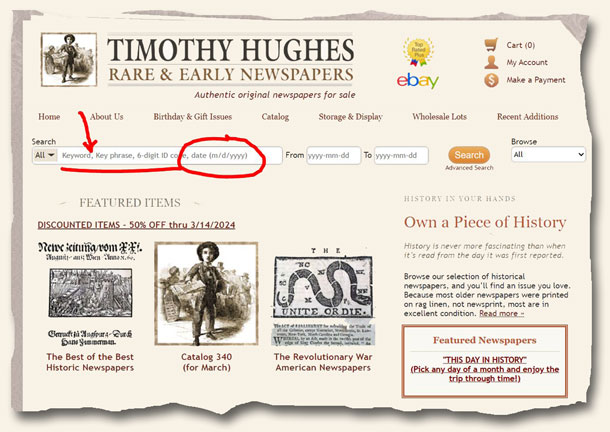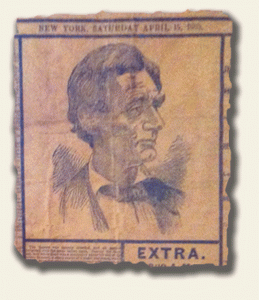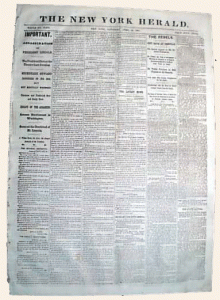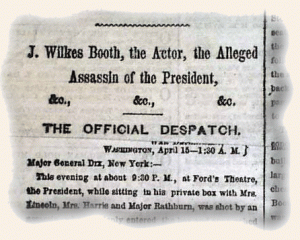“Collecting Newspapers – The Basics” (Part IV) – Setting Values…
March 25, 2024 by TimHughes · 532 Comments
We are often asked “What’s my newspaper worth?” in phone calls and email messages. As one might suspect, there are many factors which determine value and much like a jeweler cannot give a value of a diamond by an email or telephone inquiry, our ethics do not permit us to place values on newspapers without seeing the issues in hand.
Many factors determine value. The more important include condition, desirability among collectors, extent of coverage, completeness of the issue, proximity of the city of publication to where the event happened, time lag between the event date and the reporting date, dramatic appeal (more so with 20th century issues), and location of the report within the issue (front page? page 3?). Other factors come into play with more significant events but those noted are the prime determinants of value.
From a personal perspective setting values has been an interesting process, as no guide book of values existed 30+ years ago when I started the business. I priced an item in my catalog for $10 and if I had twenty orders for it I knew the price was too low. If no one ordered it the price was too high. Through the years, and by data basing sold prices (on index cards prior to the computer!), I’ve honed my own “price guide” based on actual sales, and it is this now-sophisticated database which we use to set values for new inventory as it arrives.
Do values continue to rise? In general, yes, but we are careful to never recommend the purchase of early newspapers for investment purposes. As is true of most collectibles, rarity and desirability determine where prices will be for the future.
But providing an historical perspective from our own files, back in October of 1981 we sold in our catalog #26 the NEW YORK HERALD of March 5, 1865 reporting the inauguration of Abraham Lincoln, very nice condition, for $70. In 2018 we sold another issue of the NEW YORK HERALD of March 5, 1865, also in very nice condition, for $745. If we had a similar issue today, it would likely go for around $1,000 – and even more if offered through a prominent auction house.
So, what do you do if you have a newspaper and would like to know its approximate value? One resource is this Blog – not for posting questions, but for exploring. We have many posts which provide specific examples of issues and their prices. Perhaps a better resource is the Rare & Early Newspapers website which provides 10,000+ examples (best to search by date and look for a comparable – see image below). Once you’ve explored these avenues, you are always welcome to contact us directly by email (guy@rarenewspapers.com). We would need the exact title and exact date of each issue to get started. Sending only photos does not work for us.
What two resources are not helpful?
1) Ebay. Why? Just because someone is asking for an amazing price doesn’t mean they’ll ever sell it at that price. “Previous Sales” are what matters.
2) Posting a question on this Blog. Why? We rarely monitor it.
Feel free to send any additional questions concerning the valuation of newspaper to us at the same email shown above. We’ll do our best to answer any that come our way… and who knows, perhaps they show up in a future post. 🙂
Lincoln Assassination Newspapers Atlas…
January 14, 2016 by GuyHeilenman · 2 Comments
Rick Brown been collecting Lincoln assassination newspapers for over 50 years. He has also been a historic newspaper dealer and bought, sold, or brokered in excess of one million historic newspapers. Currently he has in about 200 original Lincoln assassination newspapers – Both Union and confederate. In that same time he been setting aside reprints of the April 15, 1865 New York Herald as he came across  them. In 1992 he self-published “An Atlas of Known April 15, 1865 New York Herald Reprints.” In that work, all pages of 17 different reprint versions were shown. With concentrated efforts in 2015 he contacted a few major institutions and has now discovered 48 different/variants of this edition. His online version of the current atlas that shows all pages of 45 different variants. Also included in this online atlas is background information about the reprints – who published, when, how many pages, etc. The URL for his online Atlas is: http://www.historyreference.
them. In 1992 he self-published “An Atlas of Known April 15, 1865 New York Herald Reprints.” In that work, all pages of 17 different reprint versions were shown. With concentrated efforts in 2015 he contacted a few major institutions and has now discovered 48 different/variants of this edition. His online version of the current atlas that shows all pages of 45 different variants. Also included in this online atlas is background information about the reprints – who published, when, how many pages, etc. The URL for his online Atlas is: http://www.historyreference.
An average of three April 15, 1865 New York Herald’s are listed on eBay EVERY WEEK – that’s over 150 per year. Almost all of these listings claim there’s is an “authentic,” “original,” or “genuine” edition. In the past 15 years he has been conducting weekly searches for “April 15, 1865 New York Herald” on eBay. There have been approximately 2,250 listings for this edition on eBay and ONLY TWICE the listings were actually original editions! Also, since he has been going to estate sales and auctions for over 20 years, he has seen a few hundred of these editions offered – NOT ONE OF THEM were an original!! Over 95% of these reprints were produced over 100 years ago so they LOOK OLD, Looking old does not necessarily mean it is an original. Buyer beware – Collector value for these reprint editions is $10-$20 depending on condition.
If you have a Lincoln-related Web site or know someone that does, please have them add a link to my online atlas.
Rick Brown
http://www.historyreference.
A Nonprofit Organization
Escape from the zoo…
September 5, 2011 by TimHughes · Leave a Comment
The “New York Herald” of Nov. 9, 1874 had a very lengthy article reporting an “Awful Calamity” “The Wild Animals Broken Loose from the Central Park” with many other one column headlines. This full page article–with considerable detail–reports that all the animals had escaped their cages & were roaming free in the park, leaving dozens of people “…mutilated, trampled, and injured…” not to mention killed.
The problem was it never happened. At the very end the writer admits it’s a completely made up version of what might happen if conditions in the zoo aren’t improved. But how many people read all the way to the end of this very lengthy article? Apparently not many considering the panic which gripped New Yorkers that day. The entire city fell into a frenzy before finding out that it was all a hoax. (credit “Ephemeral New York”)
This much abbreviated report in this post was taken from the “New York World” issue of Jan. 13, 1888. See the hyperlink for the lengthier, original report found in the “Herald” of 1874.
A fascinating hoax issue which resulted in real-life panic:
April 15, 1865 New York Herald reprints… revisited…
November 1, 2010 by GuyHeilenman · 10 Comments
 A previous post by guest contributor Rick Brown detailed how one can identify whether or not their April 15, 1865 New York Herald is authentic. One of the most notable differences between an authentic issue (which is quite rare) and one of the reprints (which are rather common) is that the common reprint has an image of President Lincoln on the front page, whereas, the original does not. We recently came across a photo of the Lincoln image (as shown to the right). If your issue has it… unfortunately, your’s is not an original.
A previous post by guest contributor Rick Brown detailed how one can identify whether or not their April 15, 1865 New York Herald is authentic. One of the most notable differences between an authentic issue (which is quite rare) and one of the reprints (which are rather common) is that the common reprint has an image of President Lincoln on the front page, whereas, the original does not. We recently came across a photo of the Lincoln image (as shown to the right). If your issue has it… unfortunately, your’s is not an original.
Your help would be appreciated…
June 14, 2010 by TimHughes · 10 Comments
 Rick Brown, not unknown in our little world of newspaper collecting, is embarking upon a project and seeks your help.
Rick Brown, not unknown in our little world of newspaper collecting, is embarking upon a project and seeks your help.
Rick published “Collectible Newspapers” for many years and created the Newspaper Collectors’ Society of America along with producing several projects which remain valuable to our hobby today, including the “List of Common Reprints” found on our website. His current project is producing a list of all known reprint editions of the New York Herald of April 15, 1865, perhaps the most commonly reprinted newspaper on the market. He has identified 35 different versions and is lacking a few including:
* Kitchel’s Liniment for 1890, 1892 through 1899, 1903 and 1904, 1906
through 1908. (The date for each can be found at the
top margin of page 2.)
* Smith’s Buchu Lythia Pills
He also wishes to produce a reprint of the front pages of each of the four
genuine editions of the newspaper for free online use. Should you have a genuine New York Herald, April 15, 1865 in your collection, or one of the reprint edition editions noted above, please be in touch with Rick directly for details on how to assist in his project: Curator@historybuff.com
James Gordon Bennett and his New York Herald…
April 8, 2010 by TimHughes · Leave a Comment
A book I am currently reading, “An Empire of Wealth” by John Steele Gordon, has a page or two concerning newspapers, mostly focused on the innovations of James Gordon Bennett (image to the left is from the Harper’s Weekly dated July 10, 1858) and his “New York Herald“, offering some insights new to me and likely new to you. It is a bit lengthy but has some interesting information I felt was worthy of sharing:
 “The biggest difference between the newspapers of the pre-industrial world and those of today was politics. Most general-interest newspapers were the instruments of political factions, praising one party and excoriating all others. They were, in reality, little more than an editorial page wrapped in some highly tendentious news.
“The biggest difference between the newspapers of the pre-industrial world and those of today was politics. Most general-interest newspapers were the instruments of political factions, praising one party and excoriating all others. They were, in reality, little more than an editorial page wrapped in some highly tendentious news.
A Scots immigrant to New York, James Gordon Bennett, changed all that. Born in 1795 into one of Scotland’s few Catholic families, Bennett was always a man apart, which can be an asset for a journalist. He was also remarkably ugly, with severely crossed eyes. When a young journalist interviewed him in the 1850’s at his office across from New York’s City Hall, he reported that Bennett ‘looked at me with one eye, while he looked out at the City Hall with the other.’
Well educated in Aberdeen, he wrote his first piece of journalism about the Battle of Waterloo, when he was twenty, and four years later, sensing greater opportunity, immigrated to the United States. He worked at a series of newspapers from Boston to Charleston before settling in New York where, three times, he tried to found a newspaper that would expound Jacksonian principles. Each attempt was a failure.
Steam, however, was changing the newspaper business as it was changing everything else by the 1830’s. The new rotary presses, powered by steam, could turn out thousands of copies of a newspaper a night and at a much lower price than had been possible before. Bennett decided to try something new. On May 6, 1835, with $500 in capital, an office in a dank cellar, and himself as the only employee, Bennett began publishing the “New York Herald“.
Bennett made the Herald nonpartisan in its news articles, sought always to be the first with the news, and sold it to a mass audience by having it hawked on the streets at a penny a copy by the armies of newsboys that would quickly become a feature of the American urban scene for more than a hundred years. None of these ideas was original with Bennett. But it was he who put them all together for the first time. He also introduced a dazzling array of other journalistic innovations. He was the first to print a weather report and to cover sports regularly. He was the first to cover business news and stock prices in a general-interest newspaper. And while ‘respectable’ papers weren’t supposed to notice such things, when a beautiful prostitute was murdered in one of New York’s more fashionable brothels, Bennett played the story for all it was worth.
The “Herald’s” circulation soared, and other papers were forced to follow suit as the city, and then the country, became transfixed with the story. Within a few years the ‘Herald” was among the city’s most successful papers. Bennett traveled to Europe, where he signed up correspondents in London, Rome and Paris to supply the “Herald” with exclusive copy, the world’s first foreign correspondents. He fought Congress to establish the principle that out-of-town newspapers had as much right to the congressional press galleries as the local papers, the beginning of the Washington press corps. He even coined the use of the world ‘leak’, to refer to the stores slipped to reporters by politicians for their own purposes.
As the telegraph began to spread across the country, Bennett exploited it to the hilt. When the Mexican Was broke out, only two years after Morse’s successful demonstration, Bennett organized a consortium of newspapers to fund a pony express from New Orleans to Charleston, which was connected to New York by telegraph. The reports the New York papers published were often days ahead of the official reports arriving in Washington.
By the time of the Civil War the “Herald” was, by far, the largest and most influential newspaper in the country, and all other major papers had followed its model, profoundly transforming the newspaper business. Its daily circulation during the war reached as high as 400,000, many times the total circulation of all American newspaper combined fifty years earlier.”
One of the best we have seen…
January 16, 2010 by TimHughes · 2 Comments
 Newspaper reports on this first successful flight of the Wright brothers in Kitty Hawk, North Carolina on December 17, 1903 can be difficult to find as perhaps half of the newspapers in print at the time reported it, and those that did often relegated the report to an inside page and just one or two paragraphs. The report can be missed even if one is looking for it.
Newspaper reports on this first successful flight of the Wright brothers in Kitty Hawk, North Carolina on December 17, 1903 can be difficult to find as perhaps half of the newspapers in print at the time reported it, and those that did often relegated the report to an inside page and just one or two paragraphs. The report can be missed even if one is looking for it.
But “The New York Herald” in its December 19 edition had one of the better reports I have seen. Not only is it at the top of the front page with a three column heading: “Wright Brothers Experimenting with Flying Machine” and yet another one column stack of heads including: “Gale No Bar To Flying Machine” “Orville and Wilbur Wright’s ‘Flyer’ Sailed Against a Twenty-One Mile Wind” “Traveled Three Miles” with more, but it also includes two photos.
This is a nice front page worth sharing.
April 15, 1865 New York Herald Reprints
September 30, 2008 by GuyHeilenman · 97 Comments
Quick note: If you have an April 15, 1865 New York Herald and it has either an illustration of Lincoln on the front page, or, if it is the “Extra 8:10 AM” edition, it is a reprint. Other reprints exist, but these are the most common. Additional information can be found below and via the Library of Congress’ website.
From our guest contributor, Rick Brown:
I have been collecting Lincoln assassination ephemera for 43 years now. Since I am listed in several directories, I average 2 to 3 telephone calls a month from people wanting to know the value of their old newspapers. In the past 43 years I have been offered the April 15, 1865 New York Herald perhaps as many as 10,000 times and only once was it an original. I’ve heard many a story like “It can’t be a reprint because my great grandfather fought in the Civil War and bought it in New York and brought it back home.” One of the strangest responses I received when I informed the owner their specimen was a reprint was: “Producing a reprint is against the law. Therefore it HAS to be an original!”
To add to the confusion, the first reprint was produced in 1871 and the last about 1908. (This does not include the reprints printed on parchment – those are still being produced today.) Thus, the reprints DO look old because they are old.
In 1995 I did extensive research into newspaper reprints including the April 15, 1865 New York Herald. At that time I documented 32 different versions. The only Herald reprint produced on rag linen was a single sheet printed on both sides. The back page has a large ad for Grain-O-Coffee (who later became the originators of JELLO) and was produced in 1871.
Due to the nation’s centennial in 1876, interest in major events in American history was high. Publishers produced literally a hundred different newspaper reprints of various titles.
Starting in 1890, Kitchel’s Liniment, a patent medicine company, produced an annual version of the April 15, 1865 New York Herald. The front and back page remained the same. Pages 2 and 3 were testimonials for Kitchel’s Liniment. At the top of page 2, centered in the margin, was the phrase “Use Kitchel’s Liniment (1890) and Forever.” Each subsequent annual reprint changed the year in the phrase. The last Kitchel’s Liniment reprint version I have found is 1908. Another patent medicine company that produced New York Herald reprints was MA-LE-NA liver pills. They, too, produced annual reprint versions but with no date indicated like with Kitchel‘s Liniment.
The assassination of President Garfield and McKinley also saw reprints of the April 15, 1865 New York Herald produced. Ford’s Theater and various museum gift shops also sold these reprints and still do today.
While very few actually indicated on the paper itself that is was a reprint, it is important to note that NONE of these reprints were meant to deceive. In the case of the patent medicines, people were hired to give the reprints away at county fairs or other places where a large quantity of people would be gathering. The reprints were a marketing device. It was reasoned that having the Lincoln assassination news on the front and back page, people would not throw them away like they would if it were just a flyer advertising their product.
In the 1930s, however, the height of the American depression, there were a few scam artists who went door to door selling a “valuable relic of American history” – An old April 15, 1865 New York Herald reprint they had obtained in quantity. Unknowing people would take what little cash money they had and purchase it for $1 or so (big money in those days.) They were hoping to sell it for much more. Meanwhile, the scam artist had moved on to another city.
Of the 32 versions I have documented, only one was printed on rag linen; the Grain-O-Coffee one. Four of the versions were single sheet and printed on both sides. All four of these have the date April 15, 1865 on the front page and April 14, 1865 on the back page. Three were printed on parchment paper and the other one on wood pulp paper. The rest of the reprints were 4-page editions. Of the 32 reprint versions, all but 6 of them have printed on the front page in the forth column from the left and about six inches down the phrase EXTRA 8:10 AM is printed. There were NO original 8:10 AM EXTRA editions produced. Originals have eight pages and were printed on rag linen.
One of my continual searches on Ebay is “April 15, 1865 New York Herald.” Currently, on average, there are 3 to 4 of these placed on Ebay on a weekly basis. Very few correctly state that they are offering a reprint. Most claim to be originals. From time to time I will send an email to the seller pointing out that their specimen is actually a reprint and referring them to my site for further information. – http://www.historybuff.com/library/refhotlist.html. Of each ten sellers I send the email to, on average, four thank me for pointing it out to them but seldom edit their listing to point out that it is a reprint; four do not respond at all; and, shamefully, two reply back with something like “You know it is a reprint, and I know it is a reprint, but THEY don’t know it’s a reprint.” In the past 12 years I have used Ebay, only ONCE was an original offered. Fortunately, very few of the April 15, 1865 New York Herald’s reprints actually sell.
Recently, yet another Herald reprint was offered on Ebay that made me snicker. The photo showed one of the single sheet reprints so badly deteriorated that it was in four pieces. The seller stated that he would not normally sell this family heirloom, but for the right price he would sell it. The minimum bid was $100,000!!! I didn’t have the heart to break his bubble.
Rick Brown
HistoryBuff.com
A Nonprofit Organization
Editor’s Note: The Library of Congress also provides a great web page which discusses this commonly reprinted issue: NY Herald Reprints





